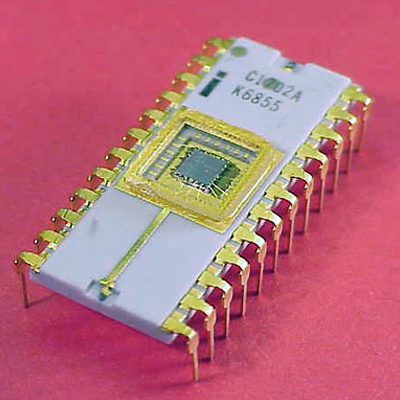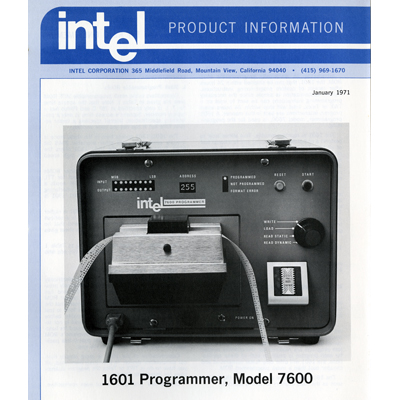博文
半导体里程_博物馆_1971 可编程只读存储器
||
多夫弗罗曼(Dov Fromana)的可擦除紫外光只读存储器的设计为微机系统的快速发展提供了重要的设计工具,被称为一个可擦写的只读程序或可编程只读存储器。
英特尔公司掩码只读存储器 (1965里程碑)模式建立在工厂,因此也需要几个星期来设计生产每个迭代。用户可编程只读存储器(PROM)的设备允许设计者在实验室中更改。1970年5月在公司推出辐射金属保险丝链接连接到512位的双极TTL电PROM ( 64x8 )每个位。一位烧用户数据的I / O ,频谱动态,以及其他一次性可编程熔丝编程单位.哈里斯(继任辐射) ,单片存储器,摩托罗拉和西格尼蒂克发展1k到16K位的镍铬保险丝的可编程只读存储器 。 AMD,英特尔,IT产业通过使用备用保险丝材料和肖特基技术 (1969年里程碑)进入市场。
1967年斯佩里兰德和贝尔实验室的研究人员独立地描述可变内存存储器可以存储MOS 栅介质中的电荷。1971 年英特尔多弗弗罗曼用浮栅(悬空)存储在可擦写只读存储器(存储器)1702中。2048 位内存设备可以改变并重复使用多次。模式是由暴露紫外线光通过包中石英窗口拭除。同时比双极设备执行要慢得多,可重用的可编程只读存储器大量被引用在微处理器 (1971年里程碑) 和微控制器 (1974年里程碑) 的原型 ROM 代码中。英特尔又继续出了几代EPROM高达数百万位密度,1978乔治·皮莱格斯设计的英特尔2816,一个电可擦除PROM ,消除了长时间的紫外线照射周期。1981 年在Seeq 与英特尔其他员工基础上Perlegos开发了一种改进的版本,可以对其进行编程和擦除原位。闪存,当今最广泛用于非易失性内存 (NVM) 的形式,是由富士男 Masuoka 的东芝开发于 1984 年和 1988 年由英特尔商业化。
当代文献:D.Kahng、 D 和施,S.M."浮栅和内存设备中的应用"贝尔系统技术杂志,火山 46,第 4 (1967) pp.1288–1295。
Wegener, H.A.R., Lincoln, A.J., Pao, H.C., O'Connell, M.R., Oleksiak, R.E. Lawrence, H."可变阈值晶体管,新的电变、 非破坏性的只读存储设备,"电子设备会议上,国际 1967年、 火山 13 (1967) 体育 70
D."内存行为在浮栅雪崩注入 MOS (FAMOS) 结构中,"弗罗曼-Bentchkowsky 卷第 18 (1971) 体育 332 应用物理快报。
弗罗曼-Bentchkowsky D."完全解码 2048年位电可编程序 FAMOS 只读存储器,"杂志的固态电路、、 火山 6,问题 5,第 301-306 页 (1971 年 10 月)
详细信息:
奥加唐斯坦"电子魔术,一块"状态的艺术: 摄影历史的集成电路。(新的避难所科技纽约: Ticknor 和字段,1983年) 体育 32。
布朗、 威廉 D.和啤酒,乔 E.(编辑) 非易失性半导体存储技术: 理解和使用自持设备综合指南。(威利 IEEE 出版社,1997 年 10 月 15 日)。
" Fujio Masuoka : 感谢记忆。 创新, "声音; 商业周刊(2006 4月3日)。
译者:哈尔滨工业大学(威海)电子封装 090840220 刘卫超
校对者:090840228 谢战胜
英文原文:
http://www.computerhistory.org/semiconductor/timeline/1971-EPROM.html
1971 - Reusable Programmable ROM Introduces Iterative Design Flexibility
Dov Froman’s ultra-violet light erasable ROM design offers an important design tool for the rapid development of microprocessor-based systems, called an erasable, programmable read-only-memory or EPROM
A masked ROM (1965 Milestone) pattern is created in the factory and thus takes several weeks to produce each design iteration. User-programmable ROM (PROM) devices allow the designer to make changes in the lab. Radiation Inc. introduced a 512-bit bipolar TTL PROM (64x8) with metal fuse links connected to each bit in May 1970. A user "burned" the one-time-programmable fuses on programming units from Data I/O, Spectrum Dynamics, and others. Harris (successor to Radiation), Monolithic Memories, Motorola, and Signetics developed 1K through 16K-bit nickel-chromium fuse PROMs. AMD, Intel, and TI entered the market using alternative fuse materials and Schottky technology. (1969 Milestone)
Researchers at Bell Labs and Sperry Rand independently described alterable memory cells that stored charge in the MOS gate dielectric in 1967. At Intel in 1971 Dov Frohman used a floating (unconnected) gate for storage in the 1702 Erasable PROM (EPROM). The 2048-bits of memory could be changed and reused multiple times. The pattern was erased by exposure to ultra-violet light through a quartz window in the package. While much slower performing than bipolar devices, re-usable EPROMs found numerous applications in prototyping ROM codes for microprocessors (1971 Milestone) and microcontrollers (1974 Milestone). Intel went on to produce generations of EPROMs up to multi-million bits in density. In 1978 George Perlegos designed the Intel 2816, an Electrically Erasable PROM that eliminated the lengthy UV exposure cycle. On founding Seeq with other Intel employees in 1981, Perlegos developed an improved version that could be programmed and erased in-situ, in the system. Flash, today's most widely used non-volatile memory (NVM) form, was developed in 1984 by Fujio Masuoka of Toshiba and commercialized by Intel in 1988.
版权 copyright by www.computerhistory.org
D. Kahng, D, and Sze, S. M. "A floating-gate and its application to memory devices," The Bell System Technical Journal, Vol. 46, No. 4 (1967) pp.1288–1295.
Wegener, H.A.R., Lincoln, A.J., Pao, H.C., O'Connell, M.R., Oleksiak, R.E. Lawrence, H. "The variable threshold transistor, a new electrically-alterable, non-destructive read-only storage device," Electron Devices Meeting, 1967 International, Vol. 13 (1967) p. 70
Frohman-Bentchkowsky, D. "Memory behavior in a floating-gate avalanche-injection MOS (FAMOS) structure," Applied Physics Letters, Vol. 18 (1971) p. 332.
Frohman-Bentchkowsky, D. "A fully decoded 2048-bit electrically programmable FAMOS read-only memory," IEEE Journal of Solid-State Circuits,, Vol. 6, Issue 5, (Oct 1971) pp. 301-306.
Frohman-Bentchkowsky, Dov (Intel) an oral history (2009-05-02)
Intel FLASH Non-Volatile Memory oral history panel - Kynett, Lai, McCormick, Pashley (2007-11-20)
Harari, Eli. (Intel, Waferscale, SanDisk) Transcript in process
Augarten, Stan. "A Piece of Electronic Magic," State Of The Art: A Photographic History of the Integrated Circuit. (New Haven & New York: Ticknor and Fields, 1983) p. 32.
Brown, William D. and Brewer, Joe E. (Editors) Nonvolatile Semiconductor Memory Technology: A Comprehensive Guide to Understanding and Using NVSM Devices. (Wiley-IEEE Press, October 15, 1997).
"Fujio Masuoka: Thanks for the Memory. Voices of Innovation," Business Week (April 3, 2006).
https://blog.sciencenet.cn/blog-652849-545902.html
上一篇:2018年春_电子封装结构设计__2.2 热控制基础 传导对流辐射
下一篇:半导体里程_博物馆_放大


